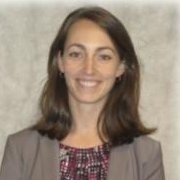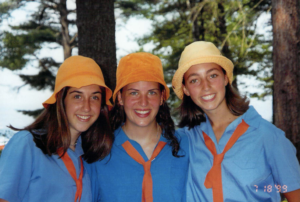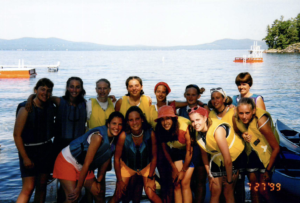We are excited to share our March Alumni Spotlight, featuring Barbara Seymour (Camper ’94-’99 Staff ’01,’02,’05), who is the Director of Development at Ceres, a nonprofit organization working with influential capital market leaders to solve the world’s greatest sustainability challenges. Through their powerful networks and global collaborations of investors, companies, and nonprofits, Ceres drives action and inspires equitable market-based and policy solutions throughout the economy to build a just and sustainable future. As Director of Development, Barbara manages key supporter relationships, special projects, and events and works to build Ceres’ brand awareness.

Read on to learn more about her work and how her time at Camp impacted her beyond the summers she was on Sebago.
It’s been a while since we’ve caught up – tell me about where life took you after Camp.
After my last summer at Camp, I went to the Peace Corps, which was an amazing experience and I highly encourage anyone thinking about it to go for it. Back on U.S. soil, I wasn’t really sure what to do next and fell into a job helping raise money for an education advocacy group. I had a fantastic boss (thank you Alice Gallin-Dwyer!), who helped me identify what I liked about my job and wanted to retain and what I wanted from my next job. Ultimately, I decided to go back to school to a brand new program called a Masters of International Business at the Fletcher School at Tufts. The program draws on the foundations of sustainability—preserving the environment, advancing social equity and inclusive growth, and ensuring responsible governance across private, public, and social organizations—to address the world’s biggest challenges and to make an impact through business innovations.
It’s almost impossible to go through Fletcher without learning about Ceres. I wasn’t necessarily looking for a development job when I graduated but when one opened at Ceres it was a good way to connect my practical experience with everything I’d studied for two years.
When I joined Ceres as a Senior Associate in 2012, we were about 40 staff with a budget of about $10 million a year, now it’s more than 200 staff with about a $45 million budget. When I joined most of our philanthropic funding came from institutional foundations, and they wanted to expand to raise money from individuals. Everything was an experiment! Each year, there’s been new growth, new opportunities, and new challenges to stay up to speed with the changes in the field of sustainability and Ceres’ programmatic growth.
And what’s Ceres all about?
Ceres is a nonprofit organization working with the most influential capital market leaders to solve the world’s greatest sustainability challenges. Through our powerful networks and global collaborations of investors, companies, and nonprofits, we drive action and inspire equitable market-based and policy solutions throughout the economy to build a just and sustainable future.
We were founded in 1989 in response to the Exxon Valdez oil spill when a group of forward-looking socially responsible investors and environmentalists led by pioneer investor Joan Bavaria came together to form Ceres. They had a vision for a better way of doing business and redefined the role and responsibility of companies as stewards of the environment and agents of economic and social change. At the time, these socially responsible investors were at the forefront of a transformative movement in business. They understood that the most successful businesses will need to consider their impacts on the environment, employees, and communities. And, that fundamental premise continues to hold true decades later. They knew then what we say now at Ceres: sustainability is the bottom line.
And back to Joan Bavaria – not only was Ceres founded by a woman, but today our executive team is all women. I don’t think I have to explain to anyone at Wawenock why that’s a powerful indicator of an organization that’s well-run and one that I see as inspiring to work for.
What’s your day-to-day like in your role?
It varies a lot, which is part of what I like about it. I work on major gifts, annual fund, and communications and marketing. I oversee operations and the budget of our team. I’m part of the crew that puts on our annual fundraiser and other events throughout the year. And I work on various special projects – last year we launched our first-ever fellowship and I’m really thrilled that our planned giving program is launching this spring. So it’s different, interesting, and challenging work every day. I drive much of how I spend my time, and that’s also really important to me.
I truly think that climate change is the biggest challenge of our generation. To borrow a metaphor from our CEO, “if a bus were coming at our children, we’d jump in front of it. Climate change is that bus.” I work at Ceres first and foremost, and the way I do that is through development.
The people make a huge difference. If I don’t enjoy the people I’m working with then why do it? What is it that’s so important that I’d spend the majority of my time at a place where I’m not valued? I’m in a very privileged position to be able to ask those questions. It’s ok to have some rough days, but if more of the time than not you wrap up your work day thinking “so glad that’s over, now what do I really want to do?” … that’s not a good feeling.
Can you share about your path to get to your position point and what’s kept you at Ceres for more than 10 years?
For all intents and purposes, we had a team of two when I started – me and our Chief Development Officer, Susan Sayers. For both of us, it was uncharted territory. As the team grew, the opportunities to grow continued as well. It’s been fun and exciting work. And Susan is someone I admire deeply and really appreciate working with. I don’t know many people of my generation who have been at the same company for 10 years. Sometimes I feel like I should look around and consider other things because that’s what you do after a while, right? But then I remind myself that doesn’t have to be true. What I’m doing is meaningful and I’m proud of my work and of Ceres. I have new opportunities and challenges. I care about and admire the people I work with. I have a balanced life, which is incredibly important to me. I’ve helped grow our team and I love helping people, and younger staff, find their way as they progress in their careers.
My husband, Rishad, and I are really lucky to have both found work we are passionate about. He has been at Cambridge Associates for about 10 years, where he leads an investment team managing the assets of large family offices, endowments, and foundations.
What’s something you feel great about? An achievement or a milestone that sticks out to you?
Helping Ceres make it through COVID and become a hybrid organization! That’s an accomplishment for sure. Maintaining and growing a team during this time frame and figuring out how to stay connected and work effectively wasn’t (and isn’t) always easy.
More specifically to my role — we are talking about revenue after all — when we brought in our first million-dollar donor that was a big deal. That was really exciting!
When talking about Ceres’ mission and how the money I raise is put to work, we just hit an inflection point. This summer Congress at last passed the Inflation Reduction Act—the most ambitious piece of climate legislation in our nation’s history. This means $370 billion will be invested in everything from clean power sources and electric vehicle supply chains, to innovative home appliances, new industrial processes, and sustainable farming practices. It’s a huge win for the field, for anyone who cares about a just and sustainable future … for the world. Over the last year, Ceres mobilized hundreds of companies and investors in support of the package, which is expected to achieve a 40% or greater reduction in U.S. climate pollution by 2030, grow the nation’s clean energy economy through substantial incentives for companies and consumers, and invest in key environmental justice initiatives to bring the benefits of climate action to rural, disadvantaged, and energy communities across the country.
What are some of the challenges you’ve faced and how have you navigated those?
Trying to figure out how to take my skill set and channel it and put it to use in the right place. Looking back, where I’ve landed is not a straight trajectory or a simple career path. Navigating that and finding the people who can help me do that hasn’t always been easy.
What advice would you give to someone who might be interested in this space or role? Or what advice might you give to your past self?
I would say first and foremost don’t go out there expecting to find your unicorn right away. Your first, second, even third, or fourth job, it’s just about testing the waters, experimenting, and finding out where your Wawenock skills help you thrive! Challenge yourself. It’s ok if it doesn’t work out, in fact, it’s probably good to try something that doesn’t. You learn from that. Look for people that can help you along that path and find your mentors.
What would someone find you doing outside of work?
Guest reading at my daughter’s Kindergarten class is where I was right before I got on the phone with you today, Dana 🙂 First and foremost, spending time with her and my family. I spend a lot of time with my dog in the Fells, a forest reservation across the street from our house. I enjoy many activities like biking (which I don’t do quite as much now that I’m not biking commuting to work), swimming and dancing. What else day to day? Reading, cooking, and with family and friends across the world, traveling (and planning that travel!). And it won’t surprise anyone from Wawenock that I love spending time in Maine especially during the summer.
Let’s turn towards Camp, the reason we are here! Can you share a favorite memory from camp?
Just one?! I’ll share a few short ones!
As a camper – singing in the dining hall, full volume – I cannot sing, and nobody judged me 🙂 Helping kids find that kind of joy is something Wawenock excels at.
June marching down the row smiling away and shouting good mornings to sleepy-headed seniors.
Sebago – anything in or on Sebago!

Being a Tribe leader (now team leader) – Most 16-year-olds weren’t spending their Sunday mornings dressed in orange being totally silly and fostering that same spirit along with healthy competitiveness in dozens of younger kids.
And then the quiet moments – time on the Images or Pat taking us (she said sneaking us) out on the end of the pier in Cabin Zero to look at spectacular stars.
I could go on forever.
What elements from Camp have helped you in your role or your journey?
It might sound like a cliche, but honestly every single one of the 10 component parts of Wawenock spirit. Beyond those, more specifically:
I joke about this a lot when I talk with Wawenock folks, but I actually have to write handwritten letters as part of my job. Not only do I know how to do it, but I also actually like doing it!
Your lifelong friendships. I have different kinds of friendships from different phases of life. But in times when it’s been rough camp friends have been some of my best support. There’s nothing quite like someone who’s known you since cabin 9.
I have a skill set to solve problems with respect and cooperation, and not everyone has that.
Just the other day at a big event I was reminded that looking people in the eye, engaging them in conversation, and including others around you – that’s actually a skill, and being a senior hostess at camp really helped me hone it.
Who was someone at Camp that impacted you?
There are so many people!
June and Pat – I feel incredibly lucky to have had so much time with both of them.
Kacy White – Before my first regatta when I was in cabin 12 Kacy White took me out in white caps and said “‘we’re gonna get you ready!” She taught me that it was ok to be nervous and to tackle that head-on and gain confidence.
Julie Butler – canoe trips with Julie were some of my favorite memories.

Last thoughts?
Keep going to camp!
The lifelong friendships that you build are so important with those people that know you in a different way. Everything we’ve talked about, you build because you’re there for 7 weeks. Of course, as a ten-year-old, I had no idea that the beauty of Sebago, the time without technology, seemingly simple things like uniforms that helped remove social pressures, etc. would provide me a solid foundation for the rest of my life.
Want to connect with Barbara or learn more about her work? Email her at blseymour@gmail.com or connect with her on LinkedIn.
The Alumni Spotlight Series is a chance to highlight alumni achievements in ‘the real world’ (as we say at Camp). We also hope that this will open up pathways to connect alumnae with one another. We want to celebrate alumnae that are doing amazing things in the world – this could be anything from running a marathon to operating a small business to being a parent to being a CEO. Achievements and success take different shapes and forms, and we look forward to highlighting alums at all stages of their journeys.
Additional information on Ceres
Forbes blog by CEO Mindy Lubber on 7 years, 7 actions.
Summary: With just 7 years left to meet our goal of slashing climate emissions in half by 2030, here are 7 actions that will be key to our success in 2023 and beyond:
- Deliver climate transition plans: Over the past two years, hundreds of asset managers and owners committed to net zero goals and Fortune 500 companies set emissions reduction targets and disclosed progress against those goals. But much more progress will be necessary.
- Transform high-emitting sectors: Focus must shift from individual company to sector action. Ceres Ambition 2030 catalyzes momentum across the six highest emitting sectors in the U.S.—banking, electric power, food and agriculture, oil and gas, steel, and transportation.
- Implement the Inflation Reduction Act: The landmark Inflation Reduction Act is built on a strong foundation of tax credits and is designed to attract investment, so its implementation will benefit from the private sector’s expertise to maximize its climate and financial benefits.
- Support a just and inclusive transition: Communities of color and marginalized populations are disproportionately impacted by the climate and water crises. Investors and companies can support a just and inclusive transition by protecting the well-being of workers and their communities.
- Value water: The water crisis escalates impacts on investors, companies, and communities. Ceres’ Valuing Water Finance Initiative — a groundbreaking effort to address water as a financial risk and make the large-scale change needed to protect water systems—elevates water to the forefront of corporate risk management.
- Tackle nature and biodiversity loss: The growing losses of biodiversity mark another outsized economic risk. Half of global GDP depends on nature. In December, investors announced the formation of Nature Action 100—a new effort to drive corporate action on tackling nature loss and biodiversity decline.
- Treat climate risk as financial risk: Last year, U.S. regulators made tremendous progress to address climate-related financial risk—most notably the SEC’s proposed rule requiring public companies to provide information on their climate risks and impacts. These regulatory advances are the result of the calls for action from investors, companies, and the public